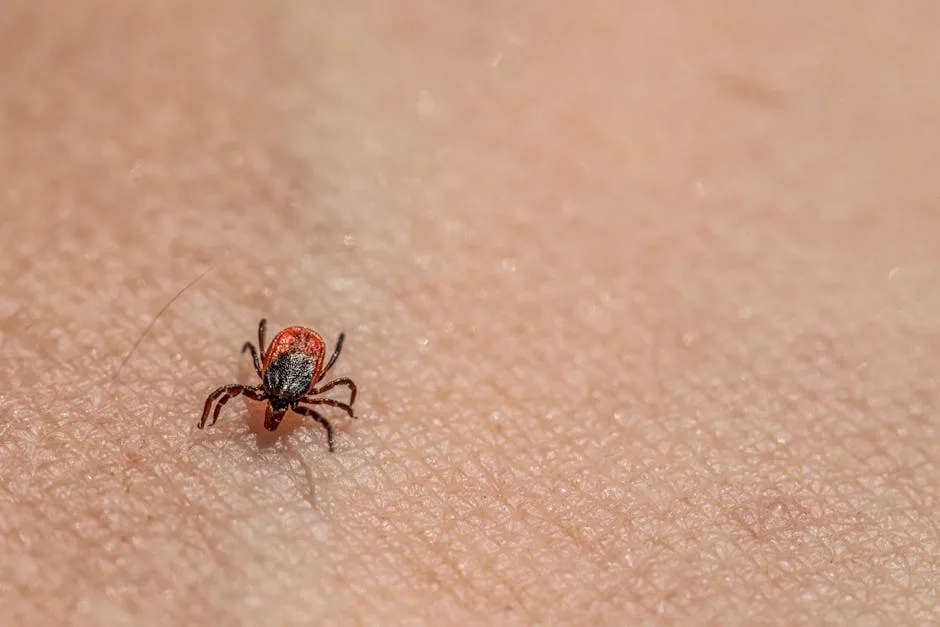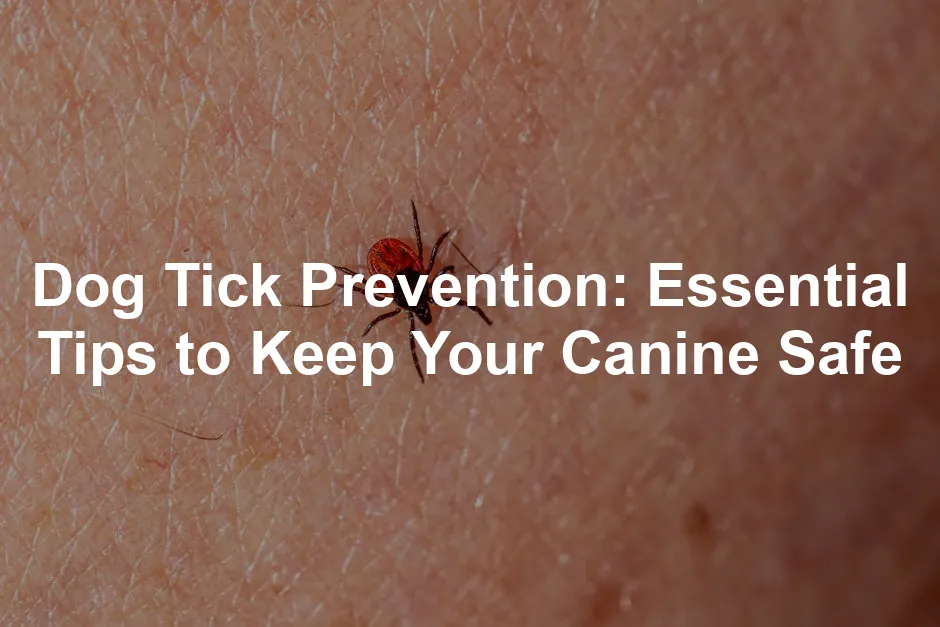Introduction
Tick prevention is vital for your dog’s health. Tick bites can lead to serious health issues. This article aims to educate dog owners on effective ways to prevent ticks.
Summary and Overview
Ticks are small parasites that attach to dogs and feed on their blood. They undergo several life stages, from larva to adult, and thrive in grassy or wooded areas. Ticks can transmit dangerous diseases, such as Lyme disease and ehrlichiosis.

Understanding the risks associated with tick bites is crucial for your dog’s health. Learn more about Lyme disease in dogs.
Statistics show that tick populations are increasing, making prevention crucial. In fact, a survey revealed that 1 in 3 dogs may encounter ticks annually. Year-round prevention is essential, as ticks can be active even in cooler months.
Various methods exist for preventing tick bites, including topical treatments, oral medications, and tick collars. Regularly checking your dog for ticks is equally important for early detection and removal. Keeping your furry friend safe is a priority, so let’s dive into effective prevention strategies!
Understanding Ticks
What Are Ticks?
Ticks are small, blood-sucking parasites. They belong to the arachnid family, closely related to spiders. Ticks have a flat, oval body that expands when they feed. Different types of ticks affect dogs, including deer ticks and brown dog ticks. Deer ticks are known for transmitting Lyme disease, while brown dog ticks can infest homes.
Ticks attach themselves to dogs by using their specialized mouthparts. They latch onto the skin and begin to feed on the dog’s blood. This feeding process can last several days, during which they can transmit diseases. Ticks are most active in warm, humid conditions and can be found in tall grass or wooded areas. Understanding the risks associated with ticks is crucial for keeping your dog healthy. Regular checks and preventive measures can make a significant difference in your dog’s well-being.
The Importance of Tick Prevention
Why Preventing Ticks is Crucial
Preventing tick bites is essential for your dog’s health. Ticks can transmit serious diseases like Lyme disease and ehrlichiosis. These conditions can lead to severe health complications if left untreated. Statistics show that over 300,000 cases of Lyme disease are reported annually in the U.S. alone.
By keeping ticks at bay, you safeguard your furry friend and your family. Learn more about dog health issues.
Untreated tick bites can cause long-term health issues, including chronic pain and joint problems. Moreover, some tick-borne diseases can affect humans too, making it vital to protect both pets and their owners. Taking proactive measures ensures a healthier and happier life for everyone involved.

Effective Tick Prevention Strategies
Year-Round Prevention
Tick prevention is crucial all year round. Many people think ticks are only a summer problem. However, ticks can remain active in cooler months. In fact, they can thrive in temperatures as low as 40°F. This means your dog is at risk even in winter. Early prevention is key. Starting tick prevention before the warm months ensures your dog is protected when ticks become active. Regularly checking your dog for ticks also helps catch any early signs of infestation.

Products for Tick Prevention
Topical Treatments
Topical treatments are popular for tick prevention. These spot-on treatments are applied directly to your dog’s skin. K9 Advantix II and Frontline are widely used options. K9 Advantix repels and kills ticks, while Frontline kills ticks after they attach. For a reliable option, check out K9 Advantix II Flea and Tick Prevention. It’s a lifesaver for many dog owners!
The pros of topical treatments include ease of application and quick effectiveness. However, they can sometimes irritate your dog’s skin. Also, if your dog swims or gets wet frequently, these treatments may wash off. For best results, apply them every month and ensure the area is dry before application.
It’s important to note that some topical products may not be effective against all tick species. Always consult your veterinarian for recommendations based on your dog’s specific needs and the types of ticks common in your area.

Oral Medications
Oral medications offer another effective option for tick prevention. Products like NexGard Flea and Tick Chewables and Bravecto Chewable Tablets for Dogs are popular choices. NexGard is a chewable that starts killing ticks within hours, while Bravecto provides up to three months of protection with one dose.
These medications work by entering your dog’s bloodstream and killing ticks when they bite. Learn more about NexGard for dogs.
These medications work by entering your dog’s bloodstream and killing ticks when they bite. Oral treatments are often preferred for their convenience and long-lasting effects. However, proper dosing is critical, so always follow your veterinarian’s instructions. Cost can vary, so consider this when choosing the best option for your pet.

Tick Collars
Tick collars, such as Seresto Flea and Tick Collar for Dogs offer convenient protection. They release active ingredients that repel and kill ticks. These collars can provide continuous defense for up to eight months, making them a popular choice for dog owners.
To ensure effectiveness, fit the collar snugly around your dog’s neck. You should be able to insert two fingers between the collar and your dog’s skin. Regularly check the collar for any signs of wear or damage, replacing it as necessary.
Keep an eye on your dog for any irritation around the collar area. If you notice any discomfort, consult your veterinarian. Proper maintenance and fitting are crucial for maximizing the collar’s effectiveness and keeping your furry friend safe from ticks.

Natural and Alternative Prevention Methods
Nontoxic approaches for tick prevention can be effective and safe. Essential oils, like lavender essential oil or peppermint essential oil, can deter ticks when diluted and used cautiously. Regular grooming is also vital; brushing your dog can remove ticks before they attach.
Always consult your veterinarian before trying natural methods. While some remedies may seem harmless, they can cause adverse reactions in certain pets.

When using natural prevention methods, apply essential oils sparingly. Test a small area on your dog’s skin first to check for allergies. Additionally, maintain a clean living environment by washing bedding and vacuuming regularly. By being proactive, you can help keep your pet tick-free and happy.

Regular Tick Checks and Removal
Daily Tick Checks
Checking your dog for ticks is essential, especially after outdoor activities. Start by looking in common areas where ticks tend to hide. Focus on the ears, between the toes, under the collar, and around the tail. These spots are often overlooked but are favorites for ticks.
Begin your check by running your fingers through your dog’s fur, feeling for any unusual lumps or bumps. Ticks can be as small as a pinhead, so take your time. If you find a tick, it’s crucial to remove it immediately to minimize disease risk. Regular inspections help catch ticks early, preventing potential health issues.

How to Safely Remove Ticks
Removing a tick properly is vital to avoid infections. First, gather your supplies: fine-tipped tweezers or a Tick Removal Tool Kit, gloves, and a small container to dispose of the tick.
To remove a tick, wear gloves and gently grasp the tick as close to your dog’s skin as possible. Pull upward with steady, even pressure; avoid twisting or jerking, as this may break the tick. If parts of the tick remain embedded, don’t panic. Use the tweezers to carefully remove them or consult your veterinarian for assistance. After removal, clean the bite area with antiseptic and monitor your dog for any signs of irritation or illness.

Please let us know what you think about our content by leaving a comment down below!
Thank you for reading till here 🙂
All images from Pexels





